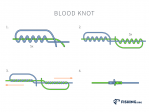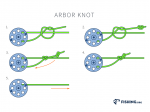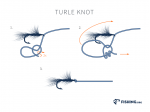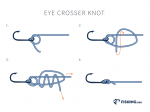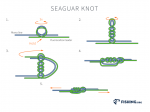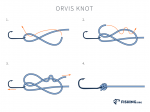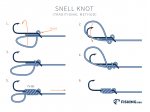Perfection Loop

How to Tie a Perfection Loop
One of the basic knots used for fishing is called the perfection loop. Tying this particular knot is not difficult but it is both effective and strong. The perfection loop is usually used when you require a loop on the end of your line. In addition to the reliability and strength of this knot it has the ability to be tied into a incredibly small loop when necessary. According to the Pro-Knot Fishing Knot Cards there are twelve knots considered to be the greatest fishing knots of all time. The perfection loop is one of these knots.
Step 2:
Step 3:
Step 4:
If fishing is your hobby, then you are already using some kind of knot to tie the worm or fly on the hook to your monofilament or fluorocarbon line.
The Perfection Loop Knot is also called the Angler’s Loop. It is the easiest way to make a small loop at the end of a leader or tippet that will lie perfectly in line with the standing end.
It is a basic knot that fishermen and women learn early on. Many believe it is a knot that enhances catching fish.
Having the knowledge of which knots to use and when is a crucial skill that not everyone masters. But the more knots you know, the easier it is to decipher.
Learning how to tie another knot and adding it to your list creates an invaluable resource. One you can turn to use in any given situation.
Is the Perfection Loop Knot Strong?
Each fishing knot has its own level of strength, which can help a fishing line remain strong. The Perfection Loop is around a 40% line strength knot, which is ideal for tasks like bait application.
The Perfection Loop is one of the best knots, especially when you require a small circle at the end of your fishing or fly line.
For instance, if you love jig fishing or targeting smaller fish, ones that are less than 12 lbs, then the Perfection Loop is excellent for anglers.
The Perfection Loop is a quick and clean loop knot that works great at the end of leaders. This knot is perhaps the most popular fly-fishing knot, as it can become a tiny circle.
Some consider the Perfection Loop to be one of the greatest fishing knots of all time.
Knot tying is typically not a challenge, but it requires practice. Taking the time necessary to learn the step-by-step process is vital.
Not only should you learn the best purposes for each knot, but how to tie them quickly and efficiently.
Tying the Perfection Loop Knot
To tie the Perfection loop knot, you can begin by:
- Make an overhand loop at the end of the line.
- Wrap the tag end clockwise around the loop.
- Keep the loop secure with your forefinger and thumb.
- Let the tag end between both loops.
- Again, secure with the thumb and forefinger.
- Reach from behind the first loop to pull the second loop through.
- Maintain pressure from forefinger and thumb to keep it from slipping.
- Pull from both ends to snug the Perfection Loop Knot.
- Trim the end tag.
Advantages and Disadvantages of the Perfection Loop Knot
Advantages:
- Slim when drawn tight
- Stable in both fresh and saltwater
- Allows convenient and quick leader changes with loop-to-loop connections.
- Easily tied with hands
- You can adjust the size to make a micro angler's loop knot as per choice.
- Reliable in slippery and fine lines as well
Disadvantages:
- Jams badly
- Not suitable if the knot needs to be untied
Conclusion
After you tie a perfect Perfection Knot for the first time, every time after that, you will become more comfortable with tying them. It is worth learning as the Perfection Loop Knot is a basic knot you should know.
 Carla Arbuckle
Carla Arbuckle 
